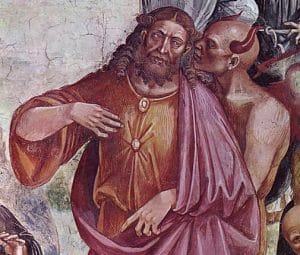When the wall separating east from west in Berlin fell, millions of people were freed from the shackles of Communism in Eastern Europe and Russia. The man who was instrumental in this happening, St. John Paul II, saw it as part of his divine mandate to facilitate this monumental event. But as a Catholic who had a great devotion to Our Lady of Fatima, he knew that was not the end of the story. Russia had spread her errors practically unabated for 75 years; reaching even into our own country. These errors were not Communism itself, but instead the ideology that underlies it—Marxism. Marxism is alive and well and is poised to become a global religion through the likes of not just China’s hegemonic aspirations, but the World Economic Forum’s Great Reset, WHO’s universal healthcare plan (led by Marxist Director General Tedros Adhanom Ghebreyesus), Black Lives Matter and a whole host of other organizations.
A Global Religion?
To call Marxism a global religion, may, at first glance, seem to be an exaggeration. Of course, properly speaking, it is not a religion at all. Religion is always ordered to God which means that there can be only one true global religion. It is the one founded by God Himself in the Catholic Church. But the Devil is always on the prowl to ape Christ including by forming his own global religion. Marxism is the “religion” of choice and should properly be seen as the religion of the Antichrist.
That Marx himself was under demonic influence can hardly be disputed. Several of his biographers, many of whom are sympathetic to his cause, have mentioned this. Paul Kengor, in his new book The Devil and Karl Marx, does a thorough job of compiling the case for Marx’s diabolical connections. Viewed in this way, it also helps to understand the beguiling effect that Marxism has on a lot of people because of its inherent power of mass Demonic Oppression. The Fathers of the Second Vatican Council were aware of this as they included several schemas on “The Care of Souls with Regard to Christians Infected with Communism” in their preparatory documents. Unfortunately, these schemas never saw the light of day and would have been a great aid in fighting an “invention so full of errors and delusions.”
The Great Imitation
Besides the global aspirations of Marxism, there are other, more insidious ways in which it will imitate the true religion. In taking on human flesh in the Incarnation, Christ sought to both repair and elevate human nature making it capable of sharing in the Divine Nature. In simplest terms, Marxism is an attempt to fundamentally transform human nature through the instruments of politics and culture. It may have failed to control economics, but that was not the end of it. Using the Sexual Revolution, Cultural Marxists have been wildly successful in “transforming” human nature in the sexual realm. No longer does human nature thrive through monogamous marriage, the family, and private property. Parents are not uniquely suited to mold their children according to their nature, but instead human nature is malleable and should be molded into the image deemed useful by the State. Free will, the mark of the Divine image in man (c.f. CCC 1704-1705), is an illusion and replaced through conditioning according to their social structure (or through the correction of “Unconscious Bias” as the remains from obsolete social structures and implemented through “Corporate Training”).
Christianity worships Christ Who made Himself a victim for our sins (c.f. 2 Cor 5:21) while Marxism worships the Victim Class. Man’s nature is not social and marked by complementarity but instead is competitive. It is to be informed by the narrative of oppressor versus oppressed. There is a never-ending search of the new victim class in order to keep the worship going. Virtuous men and women, those who are most like God are scorned and those who have been intersected by the most “axes of oppression” are exalted.

Finally, just as Catholics offer the blood of the Innocent Lamb of God to the Father, Marxists offer the blood of innocent children through abortion to the Devil. Marxism and abortion are always a package deal because Marxism, like all religions, needs to offer sacrifice. The Devil throughout history has always demanded the blood of the innocent in sacrifice. Marxism in all its instantiations always includes abortion. It was Russia that became the first country to legalize abortion in 1920 and thanks to the Marxist feminists of the 1960s, the United States followed suit. You can often identify a Marxist by how insistent they are that abortion is a “right”.
The Spirit of Christ animates the Christian religion and so the spirit of the antichrist animates the religion of Marxism. The globalists who seek a One World Order are Marxists at heart. Once a critical mass is met, then the world will be ready for the antichrist. This is not an inevitability however and so Catholics must fight against Marxism in all its manifestations. The Church was once instrumental in fighting Communism, but now it too has been infected with Marxists. We need to pray that Christ will once again cleanse the Temple by setting his sights not on the money changers but the Marxists. We have Our Lady of Fatima on our side and we can fight its spread through the First Saturday Devotion. We can also zealously combat the errors where we see them and educate ourselves on this most pernicious enemy because there is one other thing the religion of the antichrist does—seeks to wipe out the believers of the True Faith.


